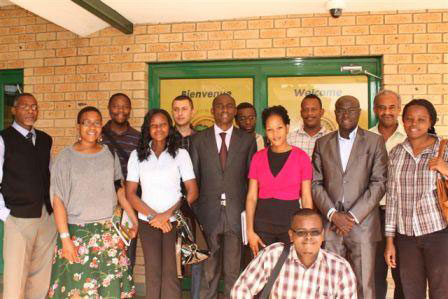African Transport Views Bridge

The New Partnership for Africa's
Development (NEPAD), an organization located in Johannesburg Midrand,
South Africa is worth following. It has marshaled interest and moved the
marble toward a Pan-African led solution to challenges facing the continent,
challenges that many in air cargo are thinking about as South Africa shows
itself to be the next big market, with many already actively seeking partnerships
there.
During this meeting season, with the glitz-and-cheese-tray
air cargo bunch about to meet next week in Amsterdam, it is also worth
taking a moment to step back and consider everything as part of an expanded
season of enlightenment.

Pictured at NEPAD 2010—Journalists covering
the event.
Earlier this month from October
13-15, NEPAD conducted an important albeit overlooked conference, The
2010 African Transport Summit, which was held in Gallagher Convention
Center in Johannesburg.
The gathering followed the first ever NEPAD
Transport Summit, held in South Africa from the 25th to the 26th of November
in 2009.
The bigger 2010 Transport Summit continued
the NEPAD mantra of working toward uncovering ways in which to prioritize,
develop and fast-track Africa's cross-border networks in all forms of
transport—road, rail, air and sea ports—to promote trade,
investment and growth through the integration of national action plans
and national economies.
Virtually every dignitary, African Minister
and guest speaker from both the public and private sector reiterated this
statement in one way or another during delivery of their presentations.
Africa stands poised to explode with development
and investment opportunities, but it will take good governance and transparency
from the politicians and the PPP’s (Public Private Partnerships)
to sustain this growth going forward.
Africa’s economy is similar to Asia’s
economy 15 years ago, and while 34 of the world’s poorest 48 nations
are in Africa, recent growth in foreign direct investment (FDI) suggests
that the continent is becoming increasingly competitive, analogous to
the experience of Asia 15 years ago. In particular, economies in Southern
Africa grew significantly over the last decade. The region’s abundance
of natural resources (e.g., minerals, energy) and its productive agricultural
sector has led to exponentially increased trade with emerging market partners
such as China, India, and Brazil. However, while the region’s balance
of trade is moving in a favorable direction, inadequate transport infrastructure
(as well as energy and information and communications technology) poses
a major bottleneck to the region achieving its full growth potential.
This year’s Transport Summit explored
issues such as the NEPAD concept of a New East-West transport corridor
(NEWCOR) that will eventually operate across the center of the continent
(from West to East) as part of an attempt to augment the already established
North-South Corridor.
 Delivering
a speech dedicating a newly completed Beit Bridge Weigh Bridge between
South Africa and Zimbabwe last week (a great example of the NEPAD push
to open and simplify trade lanes) African Director-General, Department
of Transport, Mr. George Mahlalela said: Delivering
a speech dedicating a newly completed Beit Bridge Weigh Bridge between
South Africa and Zimbabwe last week (a great example of the NEPAD push
to open and simplify trade lanes) African Director-General, Department
of Transport, Mr. George Mahlalela said:
“Africa must find solutions on our
transport infrastructure's missing links across the country and in the
region.
“We proved by the successful hosting
of the 2010 FIFA World Cup, when we hosted 3.1 million spectators through
an efficient transport infrastructure and systems, that an improved infrastructure
is a remedy for development.
“In preparation for the most exciting
global soccer spectacular for 2010, our road, rail and aviation transport
infrastructure proved to Africa and the world that sound and improved
infrastructure to include energy, telecommunication, stadium and transport
can contribute to countries achieving wonderful and memorable events of
a life time.
“Through this October 2010 African
Transport Month, we highlight our loopholes in infrastructure and discuss
possible interventions to address challenges.
“In the last two weeks we experienced
high profile infrastructure conferences. These included the NEPAD Transport
Conference in Midrand, the Road Conference hosted by the South African
Roads Federation in Cape Town and the Roads Indaba in the Eastern Cape.
“All these platforms are a clear indication
of the importance of transport infrastructure in our economies.
“The launch of the Beit Bridge Weigh
Bridge between South Africa and Zimbabwe signifies yet another milestone
in the development of cross-border transport infrastructure.
“The Beit Bridge Border Post between
South Africa and Zimbabwe close to Musina is regarded as one of Africa's
gateways to the world.”
NEPAD says that a top goal of its transport
program is to close Africa’s gap in transport infrastructure systems
and services by reducing the costs of transport and improving the quality
of services by increasing both public and private financial investment
in transport infrastructure.
NEPAD’s core belief is that improving
the maintenance of transport infrastructure will require continued removal
of formal and informal (physical and non-physical) barriers to the movement
of peoples, goods and services by supporting regional cooperation and
the integration of markets for transport services and improving the safety
of all transport modes (air, land, rail, sea and pipeline).
“Major transport corridors are under
constant review with a view to transforming them into viable spatial development
initiatives driven by transport infrastructure development,” NEPAD
says.
With respect to aviation, NEPAD says that
it has come up with a concept to implement the Yamoussoukro Decision on
the liberalization of air transport in Africa.
NEPAD has signed an MOU with the African
Civil Aviation Commission to implement the Yamoussoukro Decision, with
a focus on promoting aviation security and safety in Africa.
NEPAD is also working with Afrique Rail
and the South African Government to identify and promote regional rail
improvement.
NEPAD Agency, it should be noted, is involved
in agriculture and food security, climate change, human development, economic
and corporate issues and more.
Geoffrey/Flossie
http://www.nepad.org/.
|




